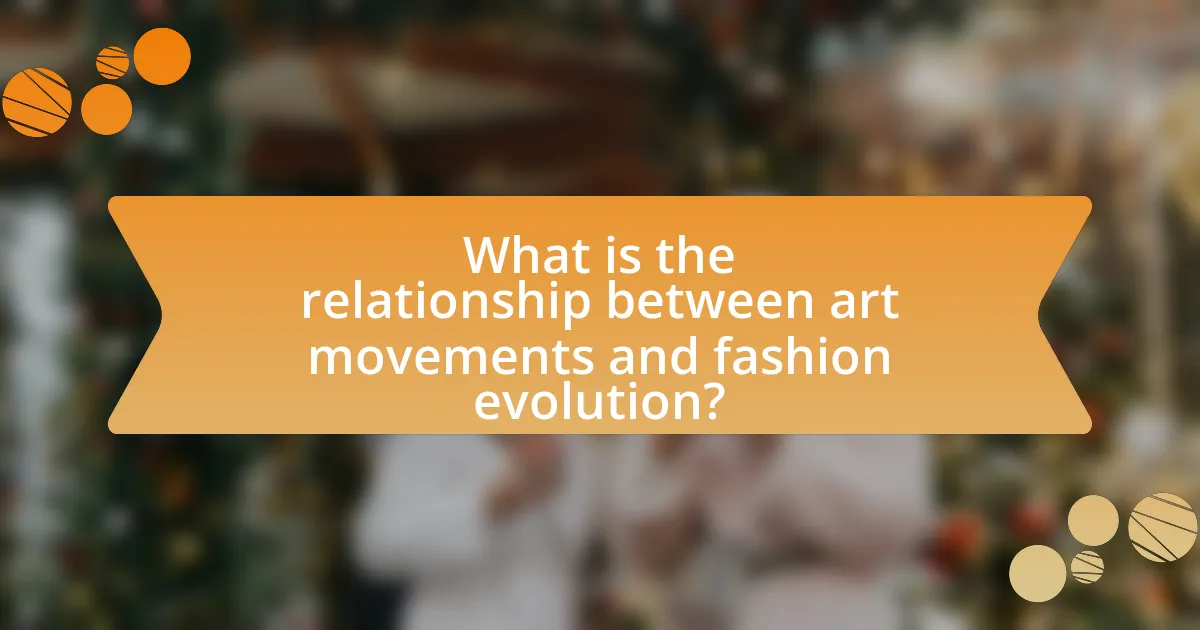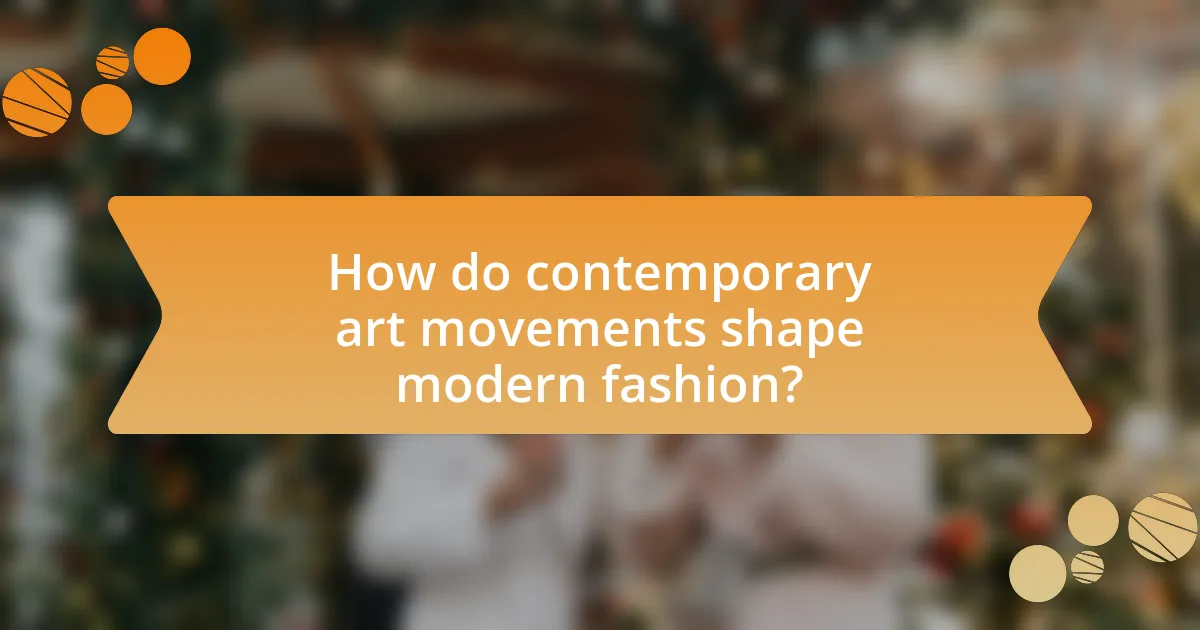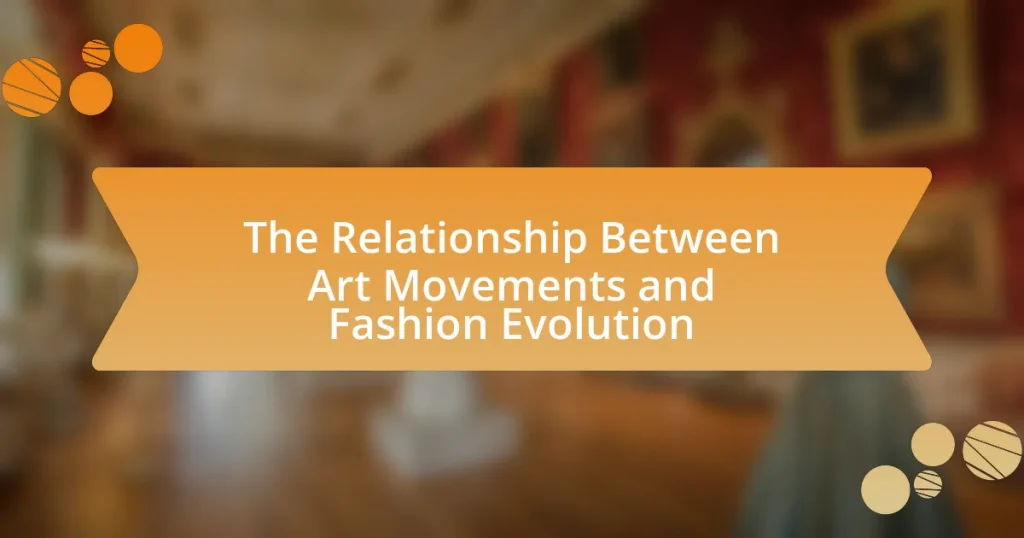The article examines the relationship between art movements and fashion evolution, highlighting how cultural, social, and aesthetic changes influence fashion trends. It discusses specific art movements, such as Impressionism and Art Deco, and their impact on fashion design, including the adoption of new aesthetics, color palettes, and design philosophies. The article also explores the characteristics of major art movements, their manifestations in fashion, and the importance of understanding this relationship for contemporary designers. Additionally, it addresses how current art movements, including street art and digital art, continue to shape modern fashion, emphasizing the interconnectedness of artistic expression and wearable design.

What is the relationship between art movements and fashion evolution?
Art movements significantly influence fashion evolution by reflecting cultural, social, and aesthetic changes. For instance, the Impressionist movement in the late 19th century inspired fashion designers to adopt lighter fabrics and softer colors, mirroring the movement’s focus on light and natural scenes. Additionally, the Art Deco movement of the 1920s introduced geometric patterns and luxurious materials into fashion, showcasing a shift towards modernity and opulence. These connections illustrate how fashion often serves as a visual representation of the prevailing artistic trends, adapting to and embodying the ethos of each art movement.
How do art movements influence fashion trends?
Art movements significantly influence fashion trends by introducing new aesthetics, color palettes, and design philosophies that designers adopt. For instance, the Impressionist movement of the late 19th century inspired fashion through its emphasis on light and color, leading to the use of softer fabrics and pastel colors in clothing. Additionally, the bold geometric patterns of the Art Deco movement in the 1920s directly impacted fashion, resulting in streamlined silhouettes and luxurious materials. Historical examples, such as the adoption of Surrealism in the 1930s, led to whimsical and avant-garde designs that challenged traditional fashion norms. These influences demonstrate how art movements serve as a catalyst for innovation in fashion, shaping trends that reflect the cultural and artistic zeitgeist of their time.
What are the key characteristics of major art movements?
Major art movements are characterized by distinct styles, philosophies, and cultural contexts that reflect the societal changes of their time. For instance, Impressionism, emerging in the late 19th century, emphasized light and color through loose brushwork, capturing fleeting moments in everyday life. In contrast, Cubism, developed by Pablo Picasso and Georges Braque, broke objects into geometric shapes, challenging traditional perspectives and representing multiple viewpoints simultaneously. Surrealism, influenced by Freudian theories, sought to explore the unconscious mind, often depicting dream-like scenes and bizarre imagery. Each movement not only influenced visual arts but also impacted fashion, architecture, and literature, showcasing the interconnectedness of cultural expressions during their respective eras.
How do these characteristics manifest in fashion design?
Characteristics of art movements manifest in fashion design through the incorporation of specific styles, colors, and techniques that reflect the ethos of those movements. For instance, the Impressionist movement influenced fashion by introducing softer colors and flowing silhouettes, mirroring the movement’s focus on light and natural forms. Similarly, the bold geometric patterns of Cubism have been translated into structured garments, showcasing angular cuts and vibrant color contrasts. Historical examples include the 1960s Mod fashion, which drew inspiration from Pop Art, featuring bright colors and graphic prints that echoed the visual language of that era. These manifestations illustrate how fashion design not only adopts aesthetic elements from art movements but also embodies their cultural significance, creating a dialogue between visual art and wearable design.
Why is understanding this relationship important?
Understanding the relationship between art movements and fashion evolution is important because it reveals how cultural expressions influence each other. This interconnectedness allows for a deeper comprehension of societal values, trends, and historical contexts. For instance, the rise of Impressionism in the late 19th century coincided with a shift in fashion towards more relaxed and natural silhouettes, reflecting broader changes in social attitudes and artistic expression. Recognizing these patterns helps scholars and industry professionals anticipate future trends and fosters innovation by drawing inspiration from historical precedents.
What insights can be gained for contemporary fashion designers?
Contemporary fashion designers can gain insights into the integration of artistic influences and cultural narratives in their work. By studying historical art movements, designers can identify how styles, colors, and themes have evolved, allowing them to create collections that resonate with current societal trends. For instance, the impact of the Bauhaus movement on minimalism in fashion illustrates how design principles can transcend mediums, emphasizing functionality and simplicity. This understanding enables designers to innovate while paying homage to artistic heritage, ultimately enriching their creative process and enhancing market relevance.
How does this relationship reflect cultural shifts?
The relationship between art movements and fashion evolution reflects cultural shifts by illustrating how societal values and aesthetics influence personal expression and identity. For instance, the rise of the Impressionist movement in the late 19th century coincided with a shift towards individualism and a break from traditional norms, which was mirrored in the fashion of the time that embraced more relaxed silhouettes and vibrant colors. This alignment demonstrates how art and fashion serve as indicators of broader cultural transformations, such as the transition from Victorian conservatism to modernity, highlighting changing attitudes towards gender roles, class, and self-expression.

What are some historical examples of art movements impacting fashion?
Art movements have significantly influenced fashion throughout history, with notable examples including the Impressionist movement, Art Deco, and Surrealism. The Impressionist movement in the late 19th century inspired designers like Paul Poiret, who embraced flowing silhouettes and vibrant colors reminiscent of Impressionist paintings. Art Deco, which emerged in the 1920s, brought geometric patterns and luxurious materials into fashion, as seen in the designs of Coco Chanel and Elsa Schiaparelli. Surrealism, prominent in the 1930s, influenced fashion through unexpected combinations and dreamlike aesthetics, exemplified by Salvador Dalí’s collaboration with Schiaparelli, which introduced elements like the lobster dress. These movements demonstrate the profound impact of artistic expression on fashion design and trends.
How did the Impressionist movement influence fashion in the late 19th century?
The Impressionist movement significantly influenced fashion in the late 19th century by promoting a shift towards more relaxed and natural styles, reflecting the movement’s emphasis on capturing light and everyday life. Designers began to favor lighter fabrics, softer silhouettes, and vibrant colors, mirroring the Impressionist palette. For example, the use of pastel shades and floral patterns became popular, inspired by the artworks of artists like Claude Monet and Pierre-Auguste Renoir, who depicted scenes of leisure and nature. This transformation in fashion was also evident in the adoption of less structured garments, allowing for greater freedom of movement, which aligned with the Impressionist ideals of spontaneity and modernity.
What specific fashion styles emerged from Impressionism?
The specific fashion styles that emerged from Impressionism include the use of light fabrics, pastel colors, and loose-fitting silhouettes. These styles were influenced by the Impressionist artists’ focus on capturing the effects of light and movement in their work, which translated into clothing that emphasized comfort and natural beauty. For instance, the shift towards lighter materials like muslin and cotton allowed for greater ease of movement, reflecting the Impressionist ideals of spontaneity and freedom. Additionally, the popularity of floral patterns and soft hues in garments mirrored the vibrant landscapes depicted in Impressionist paintings, showcasing a direct connection between the art movement and contemporary fashion trends of the late 19th century.
How did artists like Monet and Renoir inspire fashion designers?
Artists like Monet and Renoir inspired fashion designers through their use of color, light, and impressionistic techniques that translated into textile patterns and garment designs. Monet’s vibrant palettes and soft brush strokes influenced designers to adopt similar hues and fluid silhouettes, reflecting the natural world in their collections. Renoir’s focus on the human figure and the interplay of light and shadow encouraged fashion designers to create garments that emphasized movement and the beauty of the body, often incorporating flowing fabrics and delicate details. This connection between Impressionism and fashion is evident in the late 19th and early 20th centuries, where designers like Paul Poiret and Coco Chanel drew directly from the artistic principles established by these artists, leading to a significant evolution in fashion aesthetics.
What role did the Art Deco movement play in 20th-century fashion?
The Art Deco movement significantly influenced 20th-century fashion by introducing geometric patterns, bold colors, and luxurious materials. This movement, which emerged in the 1920s and 1930s, emphasized modernity and elegance, leading to the creation of streamlined silhouettes and intricate embellishments in clothing. Designers like Coco Chanel and Elsa Schiaparelli incorporated Art Deco elements into their collections, showcasing the movement’s impact on haute couture. The use of materials such as silk, satin, and metallics, along with motifs inspired by architecture and industrial design, reflected the Art Deco aesthetic and transformed fashion into a form of artistic expression.
What are the defining features of Art Deco fashion?
Art Deco fashion is characterized by its bold geometric patterns, luxurious materials, and a sense of modernity that reflects the technological advancements of the early 20th century. This style emerged in the 1920s and 1930s, showcasing streamlined silhouettes, vibrant colors, and intricate detailing, often inspired by the decorative arts and architecture of the period. The use of materials such as silk, satin, and metallic fabrics, along with embellishments like beads and sequins, further exemplifies the opulence associated with Art Deco fashion. Historical context reveals that this movement coincided with the rise of jazz culture and the flapper era, which influenced the playful yet sophisticated aesthetic of the time.
How did Art Deco reflect the social changes of its time?
Art Deco reflected the social changes of its time by embodying the optimism and modernity of the early 20th century, particularly during the 1920s and 1930s. This art movement emerged in response to the rapid industrialization, urbanization, and the cultural shifts following World War I, showcasing a departure from traditional forms and embracing new materials and technologies. The use of geometric shapes, bold colors, and luxurious materials in Art Deco design mirrored the societal desire for progress, sophistication, and a break from the past. Additionally, the movement’s emphasis on glamour and the celebration of modern life resonated with the changing roles of women and the rise of consumer culture, as seen in fashion, architecture, and decorative arts.

How do contemporary art movements shape modern fashion?
Contemporary art movements significantly shape modern fashion by influencing design aesthetics, color palettes, and cultural narratives. For instance, the rise of street art has led to the incorporation of graffiti-inspired graphics in clothing, reflecting urban culture and social commentary. Additionally, movements like minimalism have prompted fashion designers to adopt clean lines and understated elegance, as seen in brands like Calvin Klein and Jil Sander. The impact of these art movements is evident in fashion shows and collections that often draw direct inspiration from contemporary artists, such as the collaboration between Louis Vuitton and artist Takashi Murakami, which merged high fashion with pop art. This interplay between art and fashion not only drives trends but also fosters a dialogue about identity and societal issues, making fashion a medium for artistic expression.
What current art movements are influencing today’s fashion industry?
Current art movements influencing today’s fashion industry include street art, minimalism, and digital art. Street art, characterized by its vibrant colors and urban themes, has inspired fashion designers to incorporate bold graphics and graffiti motifs into their collections, reflecting a cultural shift towards individuality and self-expression. Minimalism, emphasizing simplicity and functionality, has led to the rise of clean lines and neutral palettes in fashion, aligning with sustainable practices and a focus on timeless pieces. Digital art, with its innovative use of technology, has transformed fashion through virtual fashion shows and digital clothing, showcasing the intersection of art and technology in contemporary design. These movements collectively shape the aesthetic and conceptual frameworks within which modern fashion operates.
How is street art impacting fashion design and branding?
Street art is significantly impacting fashion design and branding by infusing urban culture and social commentary into mainstream fashion. Designers increasingly draw inspiration from street art’s vibrant aesthetics and messages, leading to collaborations that elevate brand identity and appeal to younger demographics. For instance, brands like Adidas and Nike have partnered with street artists to create limited-edition collections, which not only enhance their visual appeal but also resonate with consumers seeking authenticity and cultural relevance. This trend is supported by the rise of streetwear, which has become a dominant force in the fashion industry, reflecting the influence of street art on consumer preferences and brand strategies.
What role does digital art play in fashion marketing?
Digital art plays a crucial role in fashion marketing by enhancing visual storytelling and engaging consumers through innovative designs. It allows brands to create unique, eye-catching visuals that can be easily shared across digital platforms, increasing brand visibility and consumer interaction. For instance, according to a report by McKinsey & Company, fashion brands that effectively utilize digital art in their marketing strategies can see a significant increase in customer engagement and sales, with some brands reporting up to a 30% rise in online sales after implementing digital art campaigns. This demonstrates that digital art not only captures attention but also drives consumer behavior in the fashion industry.
How can fashion designers effectively incorporate art movements into their work?
Fashion designers can effectively incorporate art movements into their work by studying the principles, aesthetics, and historical context of those movements and translating them into wearable designs. For instance, designers can draw inspiration from the bold colors and geometric shapes of Cubism or the fluid forms of Impressionism, adapting these elements into fabric patterns, silhouettes, and color palettes. Historical examples include the influence of the Art Deco movement on 1920s fashion, where designers like Coco Chanel integrated the era’s luxurious materials and streamlined designs into their collections. This approach not only honors the art movement but also creates a dialogue between fashion and visual art, enriching the designer’s work and appealing to a culturally aware audience.
What strategies can designers use to stay relevant with art trends?
Designers can stay relevant with art trends by actively engaging in continuous education and networking within the art community. Continuous education allows designers to learn about emerging styles and techniques, while networking provides insights into current trends and collaborations. For instance, attending art exhibitions, workshops, and industry conferences can expose designers to innovative ideas and influential artists. According to a study by the Fashion Institute of Technology, designers who participate in community events and collaborations are 30% more likely to adopt and adapt to new trends effectively. This proactive approach ensures that designers remain informed and inspired, allowing them to incorporate contemporary art movements into their work.
How can collaboration with artists enhance fashion collections?
Collaboration with artists can enhance fashion collections by infusing unique artistic perspectives and innovative designs that resonate with cultural movements. This partnership allows fashion brands to create visually striking pieces that reflect contemporary art trends, thereby attracting a broader audience. For instance, the collaboration between fashion designer Alexander McQueen and artist Damien Hirst resulted in collections that showcased Hirst’s iconic artwork, elevating the fashion line’s artistic value and market appeal. Such collaborations not only enrich the aesthetic quality of the collections but also foster a dialogue between fashion and art, ultimately driving consumer interest and engagement.
What are the best practices for integrating art movements into fashion design?
The best practices for integrating art movements into fashion design include thorough research of the art movement, understanding its historical context, and translating its visual elements into wearable designs. Designers should analyze key characteristics of the art movement, such as color palettes, patterns, and forms, and then creatively reinterpret these aspects to fit fashion aesthetics. For instance, the Impressionist movement’s emphasis on light and color can inspire fabric choices and garment silhouettes. Additionally, collaboration with artists or art historians can provide deeper insights and authenticity to the designs. This approach has been validated by successful fashion collections that draw directly from art movements, such as Yves Saint Laurent’s use of Piet Mondrian’s work in his 1965 collection, which showcased how art can seamlessly influence fashion.



